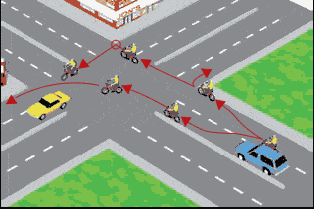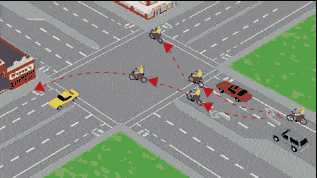 The only thing more fun than a bike ride is a safe bike ride. Follow these rules from the California Department of Motor Vehicles to make sure you get home safely.
The only thing more fun than a bike ride is a safe bike ride. Follow these rules from the California Department of Motor Vehicles to make sure you get home safely.
Bicyclists:
- Must obey all traffic signals and stop signs.
- Are lawfully permitted to ride on certain sections of roadway in rural areas where there is no alternate route.
- Must ride in the same direction as other traffic, not against it.
- Shall ride as near to the right curb or edge of the roadway as practical– not on the sidewalk.
- Are legally allowed to ride in the center of the lane when moving at the same speed as other traffic.
- May move left to pass a parked or moving vehicle, bicycle, animal, avoid debris, or other hazards.
- May choose to ride near the left curb or edge of a one-way street.
- Should ride single file on a busy or narrow street.
- Must make left and right turns in the same way that drivers do, using the same turn lanes. If the bicyclist is traveling straight ahead, he or she should use a through traffic lane rather than ride next to the curb and block traffic making right turns.
- Must signal all their intentions to motorists and bicyclists near them.
- Must wear a helmet if under the age of 18.
- Should carry identification.
- Shall not operate a bicycle on a roadway during darkness unless the bicycle is equipped with:
- A brake which will enable the operator to make one braked wheel stop on dry, level, clean pavement.
- During darkness bicyclists must have the following equipment:
- A front lamp emitting a white light visible from a distance of 300 feet.
- A rear red reflector visible from a distance of 500 feet.
- A white or yellow reflector on each pedal or on the bicyclist’s shoes or ankles visible from a distance of 200 feet.
Of course, being safe and visible only gets you so far. Safe bicycling requires safe drivers. Drivers should:
- Allow a four-second following distance. You will need this space to avoid hitting the bicyclist, if he or she brakes suddenly or falls off their bike. Bikes generally can stop faster than passenger vehicles.
- Allow the bicycle a full three feet. Although it is not illegal to share lanes with bicycle, it is unsafe.
- When you make a turn, check for bicyclists and gauge their speed before turning.
- Look carefully for bicyclists before opening doors next to moving traffic or before turning right.
- Remember that road conditions which are minor annoyances to you pose major hazards to bicyclists. Potholes, gravel, wet or slippery surfaces, pavement seams, railroad crossings, and grooved pavement can cause bicyclists to change speed or direction suddenly. If you are aware of the effect of these conditions and drive with care and attention, you can help reduce bicyclist injuries and fatalities.
 Remember: Bicycles are small, and they can easily disappear into a vehicle’s blind spots.
Remember: Bicycles are small, and they can easily disappear into a vehicle’s blind spots.
Drive cautiously, respect everyone’s right of way, and get home safely!
